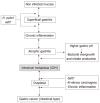Role of digital chromoendoscopy and confocal laser endomicroscopy for gastric intestinal metaplasia and cancer surveillance
- PMID: 23189218
- PMCID: PMC3506957
- DOI: 10.4253/wjge.v4.i10.472
Role of digital chromoendoscopy and confocal laser endomicroscopy for gastric intestinal metaplasia and cancer surveillance
Abstract
In Japan and countries such as South Korea and Taiwan, China, the standard technique for detecting early gastric cancer (EGC) is chromoendoscopy. This technique involves a magnified endoscope and the use of an indigo-carmine spray to distinguish between EGC and non-EGC areas. However, this technique is not widely adopted in many parts of the world. One important reason for limited use is that this technique needs an experienced endoscopist to interpret the images during the procedure. In addition, the sensitivity for detecting gastric intestinal metaplasia (GIM), a precancerous lesion of EGC, is graded as suboptimal. Moreover, the requirement of a cumbersome spraying method is inconvenient and needs preparation time. Easier digital chromoendoscopy techniques, such as Narrow-band Imaging and Flexible spectral Imaging Color Enhancement, have been reported to facilitate targeted GIM and EGC biopsy. They provide higher sensitivities over conventional white light endoscopy. Recently, the novel technology of confocal laser endomicroscopy has been introduced as a high-magnification (1000 ×) real-time evaluation for many early gastrointestinal (GI) cancers and precancerous GI lesions, including colonic polyp, Barrett's esophagus, and GIM. The advantage of this technique is that it can be used as an in vivo confirmation of the presence of GIM and EGC during endoscopic surveillance. This review aims to explain the current information on the usefulness of digital chromoendoscopy and confocal laser endomicroscopy for evaluating GIM and EGC during endoscopic surveillance and the possible future role of these techniques for GI cancer screening programs.
Keywords: Chromoendoscopy; Confocal laser endomicroscope; Gastric intestinal metaplasia.
Figures




Similar articles
-
Probe-based endomicroscopy for in vivo detection of gastric intestinal metaplasia and neoplasia: a multicenter randomized controlled trial.Endoscopy. 2017 Nov;49(11):1033-1042. doi: 10.1055/s-0043-115382. Epub 2017 Jul 28. Endoscopy. 2017. PMID: 28753702 Clinical Trial.
-
Chromoendoscopy and magnification endoscopy for diagnosing esophageal cancer and dysplasia.Thorac Surg Clin. 2004 Feb;14(1):87-94. doi: 10.1016/S1547-4127(04)00042-8. Thorac Surg Clin. 2004. PMID: 15382312 Review.
-
Cresyl violet as a new contrast agent in probe-based confocal laser endomicroscopy for in vivo diagnosis of gastric intestinal metaplasia.J Gastroenterol Hepatol. 2020 Mar;35(3):453-460. doi: 10.1111/jgh.14864. Epub 2019 Nov 13. J Gastroenterol Hepatol. 2020. PMID: 31518444
-
Flexible spectral imaging color enhancement plus probe-based confocal laser endomicroscopy for gastric intestinal metaplasia detection.J Gastroenterol Hepatol. 2013 Jun;28(6):1004-9. doi: 10.1111/jgh.12185. J Gastroenterol Hepatol. 2013. PMID: 23432088
-
Chromoendoscopy and magnification endoscopy in Barrett's esophagus.Gastrointest Endosc Clin N Am. 2003 Apr;13(2):269-77. doi: 10.1016/s1052-5157(03)00011-4. Gastrointest Endosc Clin N Am. 2003. PMID: 12916659 Review.
Cited by
-
Detection of villous atrophy using endoscopic images for the diagnosis of celiac disease.Dig Dis Sci. 2013 May;58(5):1167-9. doi: 10.1007/s10620-013-2618-9. Dig Dis Sci. 2013. PMID: 23525733 No abstract available.
-
Endoscopic surveillance of gastrointestinal premalignant lesions: current knowledge and future directions.Curr Opin Gastroenterol. 2014 Sep;30(5):477-83. doi: 10.1097/MOG.0000000000000090. Curr Opin Gastroenterol. 2014. PMID: 25003602 Free PMC article. Review.
-
Poor agreement between endoscopists and gastrointestinal pathologists for the interpretation of probe-based confocal laser endomicroscopy findings.World J Gastroenterol. 2014 Dec 21;20(47):17993-8000. doi: 10.3748/wjg.v20.i47.17993. World J Gastroenterol. 2014. PMID: 25548499 Free PMC article.
References
-
- Ferlay J, Shin HR, Bray F, Forman D, Mathers C, Parkin DM. Estimates of worldwide burden of cancer in 2008: GLOBOCAN 2008. Int J Cancer. 2010;127:2893–2917. - PubMed
-
- Ezoe Y, Muto M, Horimatsu T, Minashi K, Yano T, Sano Y, Chiba T, Ohtsu A. Magnifying narrow-band imaging versus magnifying white-light imaging for the differential diagnosis of gastric small depressive lesions: a prospective study. Gastrointest Endosc. 2010;71:477–484. - PubMed
-
- Uedo N, Ishihara R, Iishi H, Yamamoto S, Yamamoto S, Yamada T, Imanaka K, Takeuchi Y, Higashino K, Ishiguro S, et al. A new method of diagnosing gastric intestinal metaplasia: narrow-band imaging with magnifying endoscopy. Endoscopy. 2006;38:819–824. - PubMed
LinkOut - more resources
Full Text Sources

